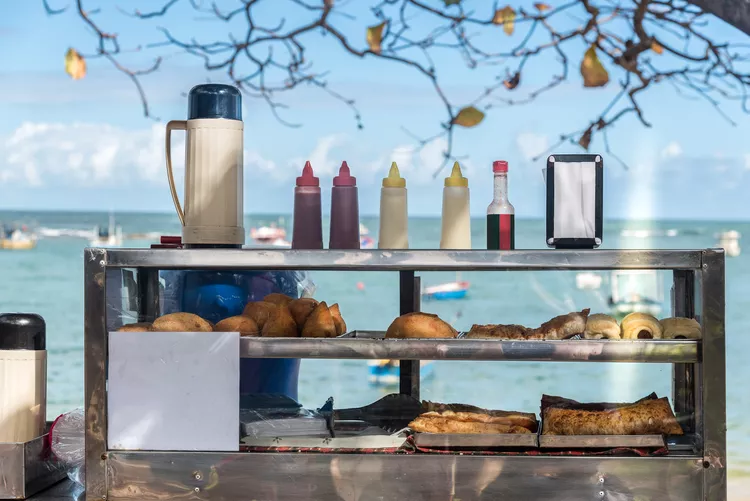Explore Tasty Brazilian Snacks
One of the best features of Brazilian cuisine is the abundance of inexpensive, easy, and tasty snacks. These can be found at just about every eating establishment: cafes, small casual restaurants called botecos, roadside rest stops, cafeterias, and outdoor street markets. While some of these Brazilian snacks may be considered street food, their place in Brazilian cuisine is important thanks to their popularity and ubiquity. So whether you want something salty with your afternoon espresso or need a quick brunch snack, these Brazilian snacks (salgados) will satisfy your hunger and give you a good introduction to popular Brazilian cuisine.
Bolinho de Bacalhau

Bolinho de bacalhau (pronounced boh-LEE-nyu dzee BAH-kah-lyow like cow), which means “little ball of cod,” is a popular snack derived from the traditional Portuguese dish of salted cod with potatoes, tomatoes, olives, and onions. A bolinha de bacalahu contains a mix of shredded codfish, mashed potatoes, and herbs, rolled together, deep-fried, and served with lime. Filling and tasty, it’s one of the best snacks found in botecos and casual restaurants in Brazil.
Empadinha

Empada, or the smaller empadinha (pronounced ehm-PAH-dah and ehm-pah-DZEE-nyah), is a mini pot pie served warm. There are usually two types: frango–chicken with peas–or palmito–heart of palm with green olives. Another tasty variety you may encounter is frango com requeijão e milho: chicken with cream cheese and corn. With a flaky crust and savory filling, an empadinha is a favorite quick snack to enjoy with coffee or juice in Brazil.
Coxinha

Coxinha is another beloved snack in Brazil. It’s enjoyed at any time of the day, often paired with caldo de cana (sugar cane juice) or suco de laranja (freshly squeezed orange juice). The shape of the coxinha resembles a chicken thigh. Inside, there’s a mix of shredded chicken and mild spices; the filling is encased in dough, covered in breadcrumbs or manioc flour, and then deep-fried. It’s commonly served alongside a bottle of red spicy sauce for extra flavor.
Pão de Queijo

Pão de queijo (pronounced pauoh dzee KAY-zhu), or warm cheese bread, is one of the most revered Brazilian snacks. They vary in quality; however, if you find them freshly baked, it’s worth purchasing a small bag to enjoy. This snack is made from tapioca flour and cheese; the dough balls are baked until the outside is slightly crispy and the inside is filled with melted cheese. As this is made with tapioca flour, it’s one of the few gluten-free options you’ll find in Brazil.
Pastel

Pastel (pronounced pah-STEU) is a favorite street snack, especially in the southern state of São Paulo, where pastel stands are common at outdoor markets. A pastel is a deep-fried pastry pocket filled with various ingredients. Common fillings include “pizza” (tomato, oregano, and mozzarella cheese), carne (ground beef, sometimes with hard-boiled eggs), bacalhau (codfish with herbs and onion), or palmito (heart of palm). Ask locals where to find the best pastelaria (pastel shop). The plural of pastel is pasteis (pronounced pah-STAYS).
Sucos

Thanks to the enormous variety of fruits, juice is a staple in the Brazilian diet. Suco de laranja (freshly squeezed orange juice, pronounced SOO-koo dzee lah-RAHN-zha) is perhaps the most common type of juice in Brazil, but dozens of types are available, including fruits from the Amazon, such as cupuaçu and açaí. Juice combinations are also popular; for instance, look for suco de laranja com mamão (orange juice with papaya), suco de laranja com acerola (shown above—orange juice with acerola, a vitamin C-rich fruit from the Amazon), and suco de abacaxi com hortelã (pineapple juice with mint).





